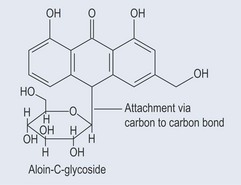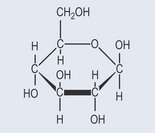Chapter 24 Glycosides
Many of the plant secondary metabolites are found naturally attached to sugars (glycosides). Mostly, the sugars are monosaccharides (Figure 24.1), such as glucose, but they can be more complicated. The sugars link to a non-sugar part called an aglycone and can be attached by separate bonds or, more commonly, as di-, tri- or tetrasaccharides. This is done by one sugar attaching to the aglycone and the others linking onto that sugar.
The linkage between the two groups can vary. It can be:

Figure 24.2 The C-glycoside linkage. The sugars attached vary in composition and can consist of one or more sugars.
The well-established naming of glycosides using the termination ‘in’ (e.g. salicin, aloin) has persisted and results in some confusion, as some substances (e.g. pectin) are not glycosides. Similar examples of this, involving isoflavones, are discussed in Chapter 21 ‘Phenols’ (p. 161). The more modern termination ‘-oside’ can be used (e.g. sennoside) to prevent confusion.
Glycosides are generally inactive and are activated by a process of hydrolysis into:
< div class='tao-gold-member'>




